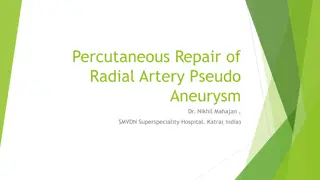Ticagrelor Monotherapy vs. 12-Month Dual Anti-Platelet Therapy After Coronary Stent Implantation for ACS
The study compares the efficacy of ticagrelor monotherapy after less than 1 month of dual anti-platelet therapy (DAPT) to 12-month ticagrelor-based DAPT in patients with acute coronary syndrome (ACS) undergoing percutaneous coronary intervention (PCI) with drug-eluting stent implantation. The aim is
1 views • 19 slides
Understanding Ventricular Septal Defect (VSD) and Treatment Options
Ventricular Septal Defect (VSD) is a common congenital heart condition characterized by a hole in the septum between the heart's ventricles. This defect can lead to various complications and is often associated with chromosomal disorders. Different types of VSD exist, each requiring tailored treatme
6 views • 72 slides
Understanding Needle Stick Injuries and Prevention
Needle stick injuries are percutaneous piercing wounds caused by needles or other sharp instruments. They pose significant risks, including exposure to blood-borne diseases. Health-care workers are particularly vulnerable, with millions experiencing such injuries annually. Proper training, safe prac
0 views • 35 slides
Tracheostomy Team Initiative & Management Inconsistencies
Tracheostomy team initiatives, led by experienced professionals, play a crucial role in delivering coordinated and effective care for patients with tracheostomies. A multidisciplinary tracheostomy team creates a supportive environment, collaborates on weaning procedures, and educates staff and patie
0 views • 25 slides
Laboratory-Acquired Infections: Routes of Exposure and Prevention Measures
The content discusses laboratory-acquired infections from 1930 to 2015 and highlights exposure routes such as facial mucous membranes, percutaneous, ingestion, inhalation, and non-traditional routes like eye and nasal cavity. It emphasizes the importance of biosafety practices, identifies GI pathoge
0 views • 21 slides
Troubleshooting Percutaneous Tube Insertion: Medical Insights by Dr. Dave Sawbridge
Explore troubleshooting aspects of percutaneous tube insertion as discussed by Gastroenterologist Dr. Dave Sawbridge from Mater Private Cork. Learn about practicalities, complications, who needs PEG/PEG-J/PEJ insertion, how the procedure is done, risks and benefits involved, and how to address poten
0 views • 9 slides
Case Study: Successful Treatment of LAD Calcified Lesion with Percutaneous Coronary Intervention
A case study dated 2024/01/06 from Far Eastern Memorial Hospital involving the treatment of a calcified lesion in the LAD artery using percutaneous coronary intervention. The procedure included wire and sheath insertion, angiography, OCT imaging revealing severe calcification, rotablation, IVL, sten
0 views • 7 slides
Enhancing Peritoneal Dialysis Options for Improved Patient Outcomes
Ensuring quality in peritoneal dialysis by providing patients with the choice between PD and hemodialysis leads to a flexible lifestyle, preservation of renal function, and potentially fewer complications. Nephrologist placement of PD catheters using a percutaneous method under local anesthetic prov
0 views • 17 slides
Percutaneous Repair of Radial Artery Pseudoaneurysm - Case Study
A 61-year-old male with a history of diabetes, hypertension, and coronary artery disease presented with abnormal body movements suggestive of seizures. Following admission and neurology evaluation, a radial artery pseudoaneurysm was incidentally discovered. Percutaneous transluminal angioplasty (PTA
0 views • 5 slides
Slipped Capital Femoral Epiphysis: Adolescent Hip Disorder
Slipped capital femoral epiphysis (SCFE) is a condition affecting the proximal femoral physis, leading to slippage of the metaphysis relative to the epiphysis. It is most commonly seen in adolescent males, particularly those who are obese. Treatment usually involves percutaneous pin fixation. Risk f
0 views • 25 slides
Coronary Angioplasty or Heart Stent Treatment in India
Heart Angioplasty or percutaneous transluminal coronary angioplasty (PTCA) means opening a blocked or narrowed coronary artery in the heart by using a balloon. Most modern coronary angioplasties are carried out by inserting a short wire mesh tube, ca
2 views • 4 slides










